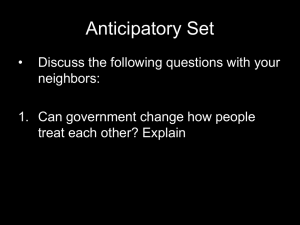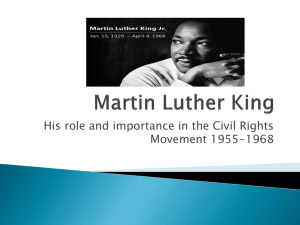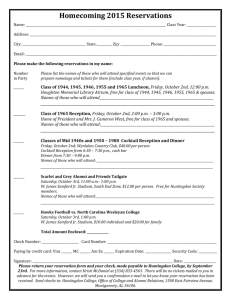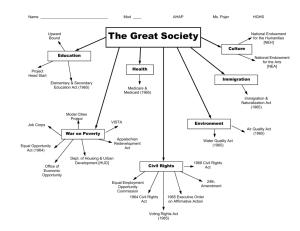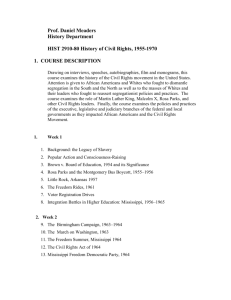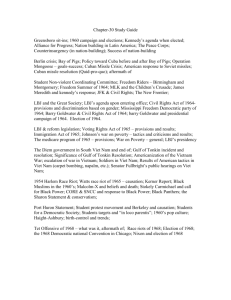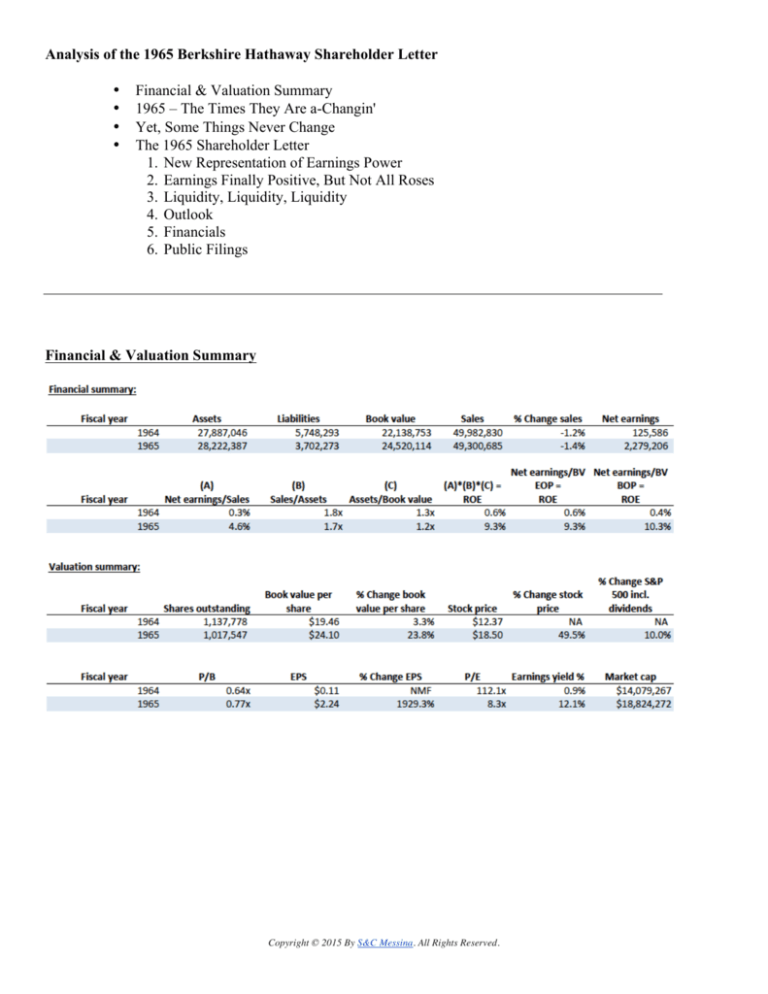
Analysis of the 1965 Berkshire Hathaway Shareholder Letter
•
•
•
•
Financial & Valuation Summary
1965 – The Times They Are a-Changin'
Yet, Some Things Never Change
The 1965 Shareholder Letter
1. New Representation of Earnings Power
2. Earnings Finally Positive, But Not All Roses
3. Liquidity, Liquidity, Liquidity
4. Outlook
5. Financials
6. Public Filings
Financial & Valuation Summary
Copyright © 2015 By S&C Messina. All Rights Reserved. 1965 – The Times They Are a-Changin'1
The first annual letter written by Warren Buffett to shareholders was written on November 9, 1965, a
few months after Buffett Partnership, Ltd., had taken formal control of Berkshire Hathaway on May
10, 1965.
This changing of the guard in 1965 represented a transformational moment in the long history of
Berkshire Hathaway. The year was a monumental fork in the road for the company – a new leader of
the enterprise, Warren Buffett, had to decide whether to continue running Berkshire just as it had
been run for the past 5 decades or radically deviate from an increasingly untenable, unprofitable
status quo. It seems as if Berkshire had also become swept up in the general winds of change and
upheaval in 1965 that were fundamentally shaking the very foundation of the United States and the
rest of the world. In the grand scheme of things, Berkshire’s identity makeover was petty, and such
timing was probably mere coincidence.
Regardless, for the sake of providing historical context, it’s helpful to take our minds back, to
imagine the emotions and thoughts we might have had during this time. The headlines on the front
page of The New York Times published on Monday, March 8, 1965, shown below, describe some of
the wheels that were set in motion in 1965, drastically altering the way we live today.2
“Marines Land to Guard Danang Base” describes the first U.S. military boots on the ground in
Vietnam when 3,500 Marines landed at China Beach on March 8, 1965, to defend the American air
base at Da Nang. This event represents a point of no return in the Vietnam War, a dark period in
American history. “Alabama Police Use Gas and Clubs to Rout Negroes” describes the first Selma
to Montgomery march, known as “Bloody Sunday”, which helped bring about the passage on August
6, 1965, of the Voting Rights Act of 1965, a quantum leap in civil rights for minorities that legally
guaranteed all Americans, regardless of race, the right to vote.
1
2
Bob Dylan, The Times They Are a-Changin' (New York: Columbia Studios. Released as single, March 8, 1965).
The New York Times, March 8, 1965.
Copyright © 2015 by S&C Messina. All Rights Reserved. 2
Yet, Some Things Never Change
Even though the world may have been brewing with uncertainty and upheaval similar to that which
filled the air in 1965, when going through the annual letters to Berkshire Hathaway shareholders, our
method of understanding the insurance and float generation strategy of Berkshire will mirror that of
Buffett’s approach when analyzing potential investments. That is, we won’t pre-occupy ourselves
with distractions occurring on the macro stage in a given year. We will take a bottoms-up approach
by focusing on the fundamentals of Berkshire itself.
Buffett elaborates on this bottoms-up approach in the 1994 shareholder letter and directly references
the Vietnam War that had rapidly escalated in 1965, 30 years earlier:
We will continue to ignore political and economic forecasts, which are an expensive
distraction for many investors and businessmen. Thirty years ago, no one could have
foreseen the huge expansion of the Vietnam War, wage and price controls, two oil
shocks, the resignation of a president, the dissolution of the Soviet Union, a one-day drop
in the Dow of 508 points, or treasury bill yields fluctuating between 2.8% and 17.4%.
But, surprise - none of these blockbuster events made the slightest dent in Ben
Graham's investment principles. Nor did they render unsound the negotiated
purchases of fine businesses at sensible prices. Imagine the cost to us, then, if we had
let a fear of unknowns cause us to defer or alter the deployment of capital. Indeed, we
have usually made our best purchases when apprehensions about some macro event were
at a peak. Fear is the foe of the faddist, but the friend of the fundamentalist.3 [emphasis
added]
When looking at Berkshire itself, while we will be using Ben Graham’s investment principles and
Charlie Munger’s approach of buying fine businesses at sensible prices, we will be applying this
bottoms-up approach on capital flows going in the opposite direction.
In other words, Ben Graham and Charlie Munger are talking about your money going out to pay for
future cash flows coming in. We will be exploring other people’s money coming in to pay for future
cash flows going out (i.e. insurance premiums coming in to fund claims payments going out; other
forms of float). Graham and Munger’s concepts still apply; margin of safety between the price paid
and value received and the power of compounding are just as applicable when analyzing other
people’s money coming in to pay for future cash flows going out.
Since the first insurance company is not acquired until 1967, we won’t be delving into this latter
concept until our analysis of the 1967 annual letter. But for now, let’s dive into the 1965 shareholder
letter.
The 1965 Shareholder Letter
The 1965 shareholder letter is only one page, so it’s very short. But there are some interesting themes that stand
out.
1. New Representation of Earnings Power
Immediately in the first sentence of the letter, there is something a little odd. The comparable net
earnings figure from the prior year, 1964, was changed:
3
Warren E. Buffett, 1994 Chairman’s Letter (Berkshire Hathaway 1994 Annual Report: 1995).
Copyright © 2015 by S&C Messina. All Rights Reserved. 3
The fiscal year ended October 2, 1965, resulted in net earnings of $2,279,206 as
4
compared to net earnings of $125,586 for the prior year.
Net earnings for 1964 were reported as $125,586 in the 1965 shareholder letter. However, if we look
at the 1964 shareholder letter, as shown below, the net earnings figure for Berkshire when it was run
under previous management was reported higher at $175,586.
5
What’s going on? Nothing changed in the economic history for Berkshire, nor was this figure a
misprint. What happened was a change in accounting or the presentation of financial figures. Another
way of putting it would be that Buffett wanted to change the way shareholders of Berkshire held the
company accountable. The balance sheet stayed exactly the same, but the presentation of the income
statement changed significantly.
Here is the 1965 income statement showing $125,586 in net earnings for the prior 1964 fiscal year:
6
When we look at the 1964 income statement, however, net earnings for 1964 is shown as $175,586:
4
Warren E. Buffett, Berkshire Hathaway Letters to Shareholders 1965-2013 (Berkshire Hathaway Annual Reports: 2014), p. 1.
Warren E. Buffett, 2014 Chairman’s Letter (Berkshire Hathaway 2014 Annual Report: 2015), p. 133.
6
Berkshire Hathaway Inc. (1965). Form 10-K 1965.
5
Copyright © 2015 by S&C Messina. All Rights Reserved. 4
7
Why did Buffett want to show lower earnings? He did so to bring down shareholder expectations for
future performance to more realistic levels, by portraying a more accurate representation of recurring
earnings power.
He explained in the 1965 shareholder letter that actual net earnings in 1965 and 1964 were artificially
boosted by tax-deductible operating losses carried over from previous years and that any assessment
on future performance should be based on normalized earnings that take into account regularly
occurring taxes. Hence, a new line item, “Charge equivalent to Federal income taxes”, appeared in
the 1965 income statement right above net earnings. In the 1965 shareholder letter, Buffett explained
the rationale for the addition of this new line item, as follows:
Because of loss carryovers, no federal income taxes were payable by the Corporation
with respect to either of these years; however to prevent any misleading interpretation of
future earnings when loss carryovers shall not be available, the Corporation had included
in computing net earnings for 1965 and 1964 a charge substantially equal to the federal
income taxes that would be payable with respect to results of operations during each of
8
these years.
Some other significant changes in the presentation of the income statement were the major line items
flowing from net sales down to operating income. While 1964 sales and operating income were
reported the same, $49,982,830 and $527,671, respectively, in both the 1965 and 1964 income
statements shown above, the line items in between were very different.
The 1964 income statement starts with “Sales” and deducts “Cost of sales, administrative and selling
expenses” and “Depreciation” to arrive at “Operating Profit (Loss)”.
The problem for an investor looking at such figures is that it’s difficult to discern what costs are
directly related to the production of the goods produced by Berkshire. The cost of sales or cost of
good sold (COGS) consists of costs of the materials used to manufacture product (inventory) along
with the direct labor costs used to produce this inventory. Such cost of sales would exclude indirect
7
8
Warren E. Buffett, 2014 Chairman’s Letter (Berkshire Hathaway 2014 Annual Report: 2015), p. 138.
Warren E. Buffett, Berkshire Hathaway Letters to Shareholders 1965-2013 (Berkshire Hathaway Annual Reports: 2014), p. 1.
Copyright © 2015 by S&C Messina. All Rights Reserved. 5
expenses such as distribution costs and sales force and advertising costs. The 1964 income statement,
however, lumps all these direct and indirect expenses together, making the calculation of gross profit
difficult.
Under Buffett, the 1965 income statement, as shown above, fixed this problem by presenting costs
more transparently. It starts with “Net Sales” and deducts “Cost of sales”, resulting in “Gross profit”,
from which “Selling, general and administrative expenses” is then deducted to arrive at “Operating
Income”. This is a much more transparent way of presenting the operating performance of Berkshire,
as investors can assess how well management is managing costs directly related to the manufacturing
of its goods and whether revenues from the sales of such goods are resulting in a sufficient gross
profit. Furthermore, it also enables investors to more easily assess how well the company is managing
its selling, general and administrative (SG&A) expenses, which are not directly related to the
manufacturing of the core products.
2. Earnings Finally Positive, But Not All Roses
In addition to adjusting net earnings downward with normalized taxes, Buffett poured even more
realism on the parade for investors. In the 1965 letter, he implied that even though net earnings in
1964 and 1965 were finally positive for the first time since 1960, thus increasing total shareholders’
equity or book value, such positive contributions to book value don’t take into account losses suffered
from the disposal of assets related to the closing of two major plants. He wrote in the 1965
shareholder letter:
The fiscal year ended October 2, 1965, resulted in net earnings of $2,279,206 as
compared to net earnings of $125,586. These net earnings do not reflect any nonrecurring
losses incurred on the disposal of assets due to the permanent closing of the King Philip
Plants A and E in Fall River, Massachusetts, as such losses have been charged to a
9
reserve previously established for such purpose.
In fact, the positive net earnings contributed to retained earnings in 1964 and 1965 were more than
offset by estimated losses on future asset disposals during the same time period. Looking below at the
1965 statement of retained earnings, a major driver of overall change in book value or change
shareholders’ equity, one will notice $300,000 charged against surplus in 1965 and $3,000,000
charged against surplus in 1964. So, even though net earnings normalized for taxes from the past two
years were $2,404,792 ($2,279,206 in 1965 + $125,586 in 1964), this positive contribution is more
than offset by a contemporaneous charge of $3,300,000 of estimated losses on properties to be sold.
10
9
Ibid.
Berkshire Hathaway Inc. (1965). Form 10-K 1965.
10
Copyright © 2015 by S&C Messina. All Rights Reserved. 6
The $3,000,000 charge incurred in 1964 was specifically designated to cover estimated losses
stemming from the disposal of King Philip E Division, the liquidation of which began in 1964.11
However, this poses an interesting timing issue because, as per the 1965 shareholder letter, a major
chunk of this asset disposal occurred in the following 1965 fiscal year. So to which fiscal year should
the $3,000,000 charge belong? Such are the frequent shortcomings of accounting and managerial
reporting of financials, be it during 1965 or today. Buffett elaborates on this King Philip E Division
liquidation in the 1965 shareholder letter, as follows:
A major portion of the machinery at King Philip Plant E Division has been sold. We
expect to dispose of the remaining portion of this plant during the current [1966] fiscal
year. This will complete the liquidation of our unprofitable plants. The proposed sale of
the King Philip E Division will make it necessary to provide storage for raw cotton and
grey cloth for the King Philip D Division at the Hathaway Division Plant C (former
Langshaw Mill). Plans are underway to accomplish this within the current [1966] fiscal
12
year.
While it’s a comfort that these estimated losses on properties to be sold are deemed non-recurring, the
fact that such significant charges are not shown on the income statement is a reminder that simply
looking at the earnings report or income statement can be an incomplete or misleading representation
of a company’s performance. This was one of the reasons why Ben Graham was focused so heavily
on the balance sheet, as a balance sheet’s snapshot in time was less prone to similar, habitual
beautification by management of a reporting period’s operating figures (i.e. income statement). On
the flip side, simply looking at the income statement would not have allowed investors to recognize
$2,967,714 was spent in 1965 in share repurchases, resulting in a decline in the number of shares
outstanding, a positive for shareholders all else being equal.
3. Liquidity, Liquidity, Liquidity
Two ways to generate more cash on the balance sheet are to better manage balance sheet items such
as working capital and to increase cash flows via higher operating margins. Both of these were
achieved in 1965. Buffett goes into the balance sheet and the income statement improvements
achieved during the year in the 1965 shareholder letter:
During 1965 raw material, stock in process and cloth inventories were decreased by
$1,411,967 and bank loans of $2,500,000 were paid off. Also, during the year, the
Corporation purchased 120,231 of its own shares, leaving a total of 1,017,547 shares
outstanding at the end of the fiscal year.
The Corporation made a substantial reduction in its overhead costs during the fiscal
year just ended. Approximately $811,812 was invested by the Corporation during the
year in the purchase of new machinery in a continuing effort to reduce costs and to
13
improve quality. This program will continue during the current [1966] fiscal year.
The following table shows the increase in working capital from 1964 to 1965:
11
Warren E. Buffett, 2014 Chairman’s Letter (Berkshire Hathaway 2014 Annual Report: 2015), p. 135.
Warren E. Buffett, Berkshire Hathaway Letters to Shareholders 1965-2013 (Berkshire Hathaway Annual Reports: 2014), p. 1.
13
Ibid.
12
Copyright © 2015 by S&C Messina. All Rights Reserved. 7
While working capital increased, liquidity also improved significantly as less cash was tied up in
inventory, the bank note was paid off and cash and marketable securities increased from $920,089 in
1964 to $3,675,504 in 1965 ($775,504 cash + $2,900,000 marketable securities & certificates of
deposit), as shown in the table below.
Furthermore, per the analysis shown in the table below, management of working capital improved as:
• Inventory was turned over faster in 1965 with average days inventory outstanding decreasing
from 117 days to 94 days
• Average days sales outstanding improved slightly, declining one day to 55 days, while
average days payable outstanding also improved slightly, increasing two days to 20 days
• In summary, the cash conversion cycle or the average time it took Berkshire to pay for its
inventory, sell this inventory and finally receive cash from the sale decreased significantly
from 117 days to 94 days
Working capital ($USD, except share count figures) Cash Marketable securities & certificates of deposit Accounts receivable Inventories Prepaid insurance, taxes and other expense Current assets Notes payable -­‐ banks Accounts payable Accrued wages & salaries Accrued state & local taxes Social security & withholding taxes payable Current liabilities Working capital Working capital management: Days in fiscal year Inventory BOP Inventory EOP Avg. inventory Inventory turnover (COGS/Avg. inventory) Days inv. outstanding (Avg. inv./COGS*Days in period) Accounts receivable BOP Accounts receivable EOP Avg. AR Days sales outstanding (Avg. AR/Sales*Days in period) Accounts payable BOP Accounts payable EOP Avg. AP Days payable outstanding (Avg. AP/COGS*Days in Copyright © 2015 by S&C Messina. All Rights Reserved. 10/3/1964 10/2/1965 920,089 0 7,450,564 11,689,145 190,563 20,250,361 775,504 2,900,000 7,422,726 10,277,178 196,391 21,571,799 2,500,000 2,096,726 294,764 365,112 491,691 5,748,293 14,502,068 0 2,581,585 296,256 441,951 382,481 3,702,273 17,869,526 10/3/1964 10/2/1965 372 365 18,011,345 11,689,145 11,689,145 10,277,178 14,850,245 10,983,162 3.2x 3.9x 117 94 7,670,236 7,450,564 7,560,400 56 7,450,564 7,422,726 7,436,645 55 2,415,395 2,096,726 2,256,061 18 2,096,726 2,581,585 2,339,156 20 8
period) Cash (DIO+DSO-­‐DPO) conversion cycle 155 129 As per the 1965 shareholder letter, only four divisions located at two sites are continuing to be
operated by Berkshire as of the end of 1965 fiscal year-end:
1. King Phillip Plant D in Warren, Rhode Island;
2. Hathaway Synthetic, Box Loom and Home Fabrics Divisions in New Bedford, Massachusetts.14
While most of the buildings and machinery at King Phillip Plant A Division were sold during the 1964 fiscal
year, a major portion of the King Phillip Plant E Division asset disposals were accomplished in the 1965 fiscal
year. When an unprofitable plant gets shut down, any inventory stored at the closed plants can still be sold off.
While the inventory may have to be stored elsewhere, the expenses incurred (i.e. overhead, labor, etc.) from the
operation of the unprofitable plants can come to a halt. This likely explains part of the yearly decline of 11.6%
in payroll from $13,135,731 to $11,618,517, as per the table below.
The analysis below clearly indicates a massive improvement year-over-year in operating margins
from 1964 to 1965, as gross profit margin increased from 5.2% to 13.8%, operating income margin
increased from 1.1% to 9.5% and net earnings margin increased from a paltry 0.3% to 4.6%:
Operating statistics Y-­‐O-­‐Y growth: Sales Gross profit Operating income Earnings before charge equiv. to Federal inc. taxes Net earnings EPS Margins: Sales Cost of sales Gross profit Selling, general & administrative expenses Operating income Other deductions, net Idle plant, expense Other operating expenses 14
10/3/1964 10/2/1965 -­‐1.2% NA -­‐196.8% NA NA NA -­‐1.4% 162.3% 788.2% 2359.9% 1714.9% 1929.3% 10/3/1964 10/2/1965 100.0% 100.0% 94.8% 86.2% 5.2% 13.8% 4.1% 1.1% 4.3% 9.5% 0.3% 0.5% 0.7% 0.3% 0.5% 0.7% Ibid.
Copyright © 2015 by S&C Messina. All Rights Reserved. 9
Earnings before charge equiv. to Federal inc. taxes Charge equivalent to Federal inc. taxes Net earnings Depreciation & amortization Implied tax rate Copyright © 2015 by S&C Messina. All Rights Reserved. 0.4% 8.8% 0.1% 0.3% 2.2% 4.1% 4.6% 1.7% 28.5% 47.2% 10
4. Outlook
Seabury Stanton resigned as a director and President, with Kenneth V. Chace elected by the board as successor.
John K. Stanton resigned as director and as Treasurer and Clerk with Harold V. Banks elected as the new
Treasurer and Clerk.
This was perhaps the coldest send-off one might expect in a public statement regarding the termination of a
long-standing director and President, whose family had owned and operated the business for decades. While
acknowledging “fifty years of service” given by Seabury Stanton, there is nothing close to a “thank you” or
other semblance of gratitude. This send-off is in stark comparison to the expression only a few lines later of
“thanks to all the employees of the Corporation whose loyal cooperation and efforts have helped to make this
year successful.”15 The 1965 fiscal year ended with significant backlogs of unfilled order at all divisions, and
management expects the coming 1966 fiscal year to continue to be profitable.
Interestingly, the 1965 letter ends with the names of Chairman of the Board Malcolm G. Chace, Jr., and
President Kenneth V. Chace appearing at the bottom. However, the compilation of letters compiled in Berkshire
Hathaway Letters to Shareholders, 2013, denotes the 1965 letter as a “[Letter written by Warren E. Buffett]”.16
15
16
Warren E. Buffett, Berkshire Hathaway Letters to Shareholders 1965-2013 (Berkshire Hathaway Annual Reports: 2014), p. 1.
Ibid.
Copyright © 2015 by S&C Messina. All Rights Reserved. 11
5. Financials
Berkshire Hathaway Fiscal Year ($USD, except share count figures) Balance Sheet 372 365 1964 10/3/1964 1965 10/2/1965 Assets Current assets: Cash Marketable securities & certificates of deposit Accounts receivable Inventories Prepaid insurance, taxes and other expense Total current assets 920,089 0 7,450,564 11,689,145 190,563 20,250,361 775,504 2,900,000 7,422,726 10,277,178 196,391 21,571,799 Properties, plant & equipment: Properties comprising land, buildings, machinery & equip. Less accumulated depreciation and amortization Net PP&E Less estimated loss on properties to be sold Total carrying value of Net PP&E 33,635,553 21,853,689 11,781,864 4,210,621 7,571,243 28,019,742 19,593,163 8,426,579 1,809,132 6,617,447 Mortgage notes receivable & other assets Total assets 65,442 27,887,046 33,141 28,222,387 Liabilities & stockholders' equity 2,500,000 2,096,726 294,764 365,112 491,691 5,748,293 0 2,581,585 296,256 441,951 382,481 3,702,273 8,036,900 19,417,576 27,454,476 5,315,723 22,138,753 27,887,046 Liabilities Current liabilities: Notes payable -­‐ banks Accounts payable Accrued wages & salaries Accrued state & local taxes Social security & withholding taxes payable Total current liabilities Stockholders' equity Common stock Retained earnings Common stock & retained earnings Less common stock in treasury at cost Total stockholders' equity Total liabilities & stockholders' equity Copyright © 2015 by S&C Messina. All Rights Reserved. 5,688,890 20,469,068 26,157,958 1,637,844 24,520,114 28,222,387 12
Income statement Sales Cost of sales Gross profit 10/3/1964 49,982,830 47,382,337 2,600,493 49,300,685 42,478,984 6,821,701 Selling, general & administrative expenses Operating income 2,072,822 527,671 2,135,038 4,686,663 Other deductions, n et Idle plant, expense Other operating expenses Earnings before charge equiv. to Federal inc. taxes 126,060 226,025 352,085 175,586 127,348 240,109 367,457 4,319,206 Charge equivalent t o Federal inc. taxes Net earnings 50,000 125,586 2,040,000 2,279,206 Depreciation & amortization Change in retained earnings 10/2/1965 1,101,147 Balance of year at beginning Net earnings (loss) for the year Credit resulting from charge equiv. to Federal inc. taxes Retirement of treasury stock Estimated loss on properties to be sold Balance at end of year Supplemental data Shares outstanding y-­‐o-­‐y growth % Earnings per share y-­‐o-­‐y growth % Working capital y-­‐o-­‐y growth % Working capital per share y-­‐o-­‐y growth % Total stockholders' equity y-­‐o-­‐y growth % Total stockholders' equity per share y-­‐o-­‐y growth % Payroll y-­‐o-­‐y growth % Additions to properties & equipment y-­‐o-­‐y growth % Depreciation & amortization y-­‐o-­‐y growth % Copyright © 2015 by S&C Messina. All Rights Reserved. 10/3/1964 862,424 10/2/1965 22,241,990 125,586 50,000 0 (3,000,000) 19,417,576 19,417,576 2,279,206 2,040,000 (2,967,714) (300,000) 20,469,068 10/3/1964 10/2/1965 1,137,778 1,017,547 -­‐29.2% -­‐10.6% $0.11 $2.24 NMF 1929.3% 14,502,068 17,869,526 -­‐16.7% 23.2% $12.75 $17.56 17.7% 37.8% 22,138,753 24,520,114 -­‐26.9% 10.8% $19.46 $24.10 3.3% 23.8% 13,135,731 11,618,517 -­‐18.4% -­‐11.6% 288,608 811,812 -­‐56.7% 181.3% 1,101,147 862,424 -­‐35.9% -­‐21.7% 13
6. Public Filings
Copyright © 2015 by S&C Messina. All Rights Reserved. 14
Copyright © 2015 by S&C Messina. All Rights Reserved. 15
Copyright © 2015 by S&C Messina. All Rights Reserved. 16


